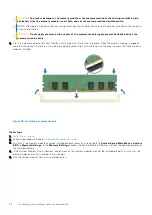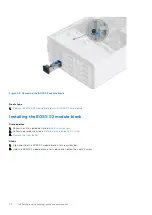
Table 18. Supported memory matrix
DIMM type Rank
Capacity
DIMM rated voltage and speed Operating speed for
DIMMs per Channel
(DPC)
UDIMM
1 R
8 GB/16 GB
DDR4 (1.2 V), 3200 MT/s
3200 MT/s
2 R
32 GB
DDR4 (1.2 V), 3200 MT/s
3200 MT/s
NOTE:
Dual rank UDIMMs with two DIMMs per channel (2 DPC) limits the speed to 2933 MT/s.
General memory module installation guidelines
To ensure optimal performance of your system, observe the following general guidelines when configuring your system memory.
If your system's memory configurations fail to observe these guidelines, your system might not boot, stop responding during
memory configuration, or operate with reduced memory.
The memory bus may operate at speeds up to 2933 MT/s depending on the following factors:
●
System profile selected (for example, Performance Optimized, or Custom [can be run at high speed or lower])
●
Maximum supported DIMM speed of the processor
●
Maximum supported speed of the DIMMs
●
Rank of the DIMMs
NOTE:
MT/s indicates DIMM speed in Mega-Transfers per second.
The system supports Flexible Memory Configuration, enabling the system to be configured and run in any valid chipset
architectural configuration. The following are the recommended guidelines for installing memory modules:
●
All DIMMs must be DDR4.
●
If memory modules with different speeds are installed, they operate at the speed of the slowest installed memory module.
●
Populate memory module sockets only if a processor is installed.
○
For single-processor systems, sockets A1 to A4 is available.
●
In
Optimizer Mode
, the DRAM controllers operate independently in the 64-bit mode and provide optimized memory
performance.
NOTE:
DIMM speed is limited to 2933 MT/s when mixing dual rank DIMMs with single rank or dual rank DIMMs in the
same channel.
Table 19. Memory population rules
Processor
Configuration
Memory population
Memory population
information
Single processor
Optimizer (Independent
channel) population order
A{1}, A{2}, A{3}, A{4}
1, 2, 3, 4 DIMMs are
allowed.
●
Populate all the sockets with white release tabs first, followed by the black release tabs.
●
Unbalanced or odd memory configuration results in a performance loss and system may not identify the memory modules
being installed, so always populate memory channels identically with equal DIMMs for best performance.
Removing a memory module
Prerequisites
1. Follow the safety guidelines listed in the
.
2. Follow the procedure listed in the
Before working inside your system
3.
.
WARNING:
The memory modules are hot to touch for some time after the system has been powered off. Allow
the memory modules to cool before handling them.
NOTE:
To ensure proper system cooling, memory module blanks must be installed in any memory socket that is not
occupied. Remove memory module blanks only if you intend to install memory modules in those sockets.
60
Installing and removing system components
















































